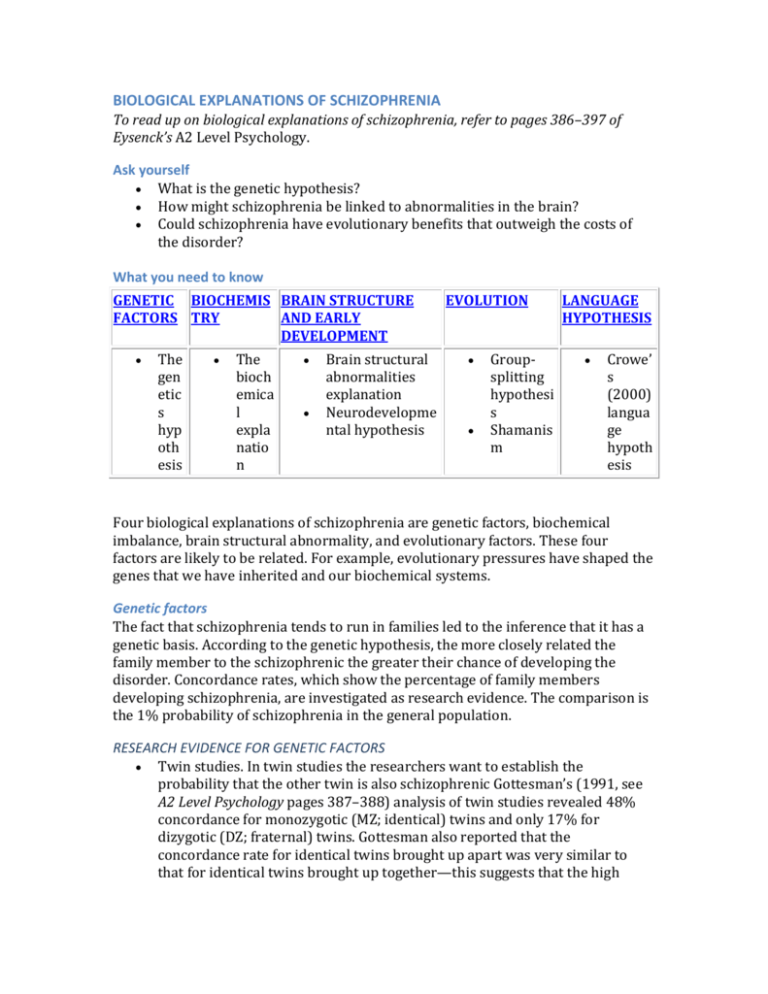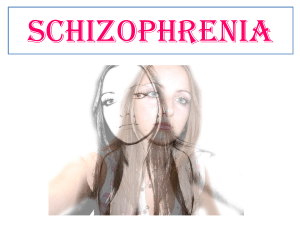biological explanations of schizophrenia
advertisement

BIOLOGICAL EXPLANATIONS OF SCHIZOPHRENIA To read up on biological explanations of schizophrenia, refer to pages 386–397 of Eysenck’s A2 Level Psychology. Ask yourself What is the genetic hypothesis? How might schizophrenia be linked to abnormalities in the brain? Could schizophrenia have evolutionary benefits that outweigh the costs of the disorder? What you need to know GENETIC BIOCHEMIS BRAIN STRUCTURE FACTORS TRY AND EARLY DEVELOPMENT The gen etic s hyp oth esis The bioch emica l expla natio n Brain structural abnormalities explanation Neurodevelopme ntal hypothesis EVOLUTION Groupsplitting hypothesi s Shamanis m LANGUAGE HYPOTHESIS Crowe’ s (2000) langua ge hypoth esis Four biological explanations of schizophrenia are genetic factors, biochemical imbalance, brain structural abnormality, and evolutionary factors. These four factors are likely to be related. For example, evolutionary pressures have shaped the genes that we have inherited and our biochemical systems. Genetic factors The fact that schizophrenia tends to run in families led to the inference that it has a genetic basis. According to the genetic hypothesis, the more closely related the family member to the schizophrenic the greater their chance of developing the disorder. Concordance rates, which show the percentage of family members developing schizophrenia, are investigated as research evidence. The comparison is the 1% probability of schizophrenia in the general population. RESEARCH EVIDENCE FOR GENETIC FACTORS Twin studies. In twin studies the researchers want to establish the probability that the other twin is also schizophrenic Gottesman’s (1991, see A2 Level Psychology pages 387–388) analysis of twin studies revealed 48% concordance for monozygotic (MZ; identical) twins and only 17% for dizygotic (DZ; fraternal) twins. Gottesman also reported that the concordance rate for identical twins brought up apart was very similar to that for identical twins brought up together—this suggests that the high concordance rate for identical twins is not due to them being treated in a very similar way within the family. Family studies show that the risk of developing schizophrenia is greater for those more closely related to the schizophrenic. If both parents have schizophrenia there is a 46% chance, with one schizophrenic parent there is a 16% chance, and it is 8% if a sibling has schizophrenia. There is a 17% chance of developing schizophrenia in families in which the identical twin of one parent has schizophrenia. This shows the influence of genes over nurture (Gottesman, 1991). Adoption studies. Tienari’s study (1991, see A2 Level Psychology page 390) showed that 10.3% of adopted children who had a schizophrenic mother developed schizophrenia in adulthood, compared with only 1.1% of adopted children who did not have a schizophrenic mother. This supports the importance of genetic factors and is evidence against the role of nurture. RESEARCH EVIDENCE AGAINST GENETIC FACTORS Torrey (1992, see A2 Level Psychology page 388) argued that many twin studies were inadequate, due to small samples and the biased allocation of twins as identical and fraternal. He reviewed eight studies in which the samples were representative and the allocation of twins was reasonably certain. He found a concordance rate of 28% for MZ and 6% for DZ twins. Similarly, Joseph (2003, see A2 Level Psychology page 388) reported from nine studies a concordance rate of 22.4% for MZ and 4.6% for DZ twins. These figures are much lower than the concordance rates found by Gottesman (1991). However, they do still show a much higher chance of schizophrenia than the 1% risk in the general population. The higher concordance rate in MZ twins may be due to the fact that MZ twins tend to be treated more similarly than DZ twins and so nurture may explain the concordance rates rather than nature. Whilst Gottesman’s (1991) finding that the concordance rates are similar for twins reared apart and together supports nature, critics have argued that the twins did not spend all of their childhood apart. Some were raised by close relatives and went to the same school and so did share a very similar environment. The fact that concordance rates increase with genetic relatedness may be explained by the fact that this is because they are also likely to spend more time together, which means environmental factors may be influential. This is supported by Joseph (2003, see A2 Level Psychology page 391) who found higher concordances in fraternal twins than ordinary siblings, which, given that they have the same genetic relatedness, points to environmental factors. Fewer than 50% of children where both parents have schizophrenia develop the disorder, which is evidence against a direct genetic link. Wahlberg et al. (1997, see A2 Level Psychology page 390) reported additional findings from the study started by Tienari, which show that environmental factors are important. They found the genetic risk of schizophrenia was increased significantly if the adopted family was high in communication deviance (a tendency to communicate in unclear and confusing ways). In fact if the family was low in communication deviance then the children had good psychological health in spite of their genetic risk. EVALUATION OF RESEARCH INTO GENETIC FACTORS Twin studies provide strong genetic evidence. As the MZ twins are genetically identical whilst DZ twins are no more alike than ordinary siblings, this supports the involvement of genetic factors. If these were not important, and instead nurture was the key determinant, then there should be no difference in the concordance rates between MZ and DZ twins. Not 100% concordance. The fact that the concordance rates are not 100% means that schizophrenia cannot be a wholly genetic disorder. Predisposition, not cause. As the disorder is not wholly genetic this leads to the conclusion that genes alone do not cause schizophrenia; instead they predispose, i.e. place the individual at a greater risk for developing the disorder. Nature vs. nurture. It is difficult to separate out the influence of nature vs. nurture. Diathesis–stress model. The question of nature or nurture lacks validity as clearly an interaction of the two takes place. The multi-dimensional approach of the diathesis–stress (genetic predisposition/nature combined with environment/nurture) model is more comprehensive than favouring one or the other. Methodological weaknesses of concordance studies. Family, twin, and adoption studies must be considered cautiously because they are retrospective, and diagnosis may be biased by knowledge that another family member has been diagnosed. Sample size. The sample size of twin, family, and adoption studies casts doubt on the generalisability of the findings and so population validity may be low. The gene-mapping study was based on a restricted number of families and has failed to be replicated, which illustrates the problems of sample bias. Reductionist. The focus on only biological factors ignores the role of psychological factors. The research on twins with identical genes shows far from 100% concordance and so schizophrenia cannot be just explained by genetics. The explanation as to why one identical twin develops schizophrenia and the other doesn’t is likely to be psychological rather than biological. Thus, we must consider more than one level of explanation, the biological explanation alone is too reductionist (simplistic). Deterministic. The genetic explanation is deterministic as it suggests that those with a genetic vulnerability have an increased risk of schizophrenia, which ignores their free will to create a psychologically healthy environment, for example one low in communication deviance (a tendency to communicate in unclear and confusing ways). This criticism can be countered because it can be argued that if the you are genetically predisposed to schizophrenia then you do not have a great deal of control over whether you develop the disorder or not. Biochemistry Genetic factors may lead to imbalances in the brain chemicals (neurotransmitters). According to the dopamine hypothesis of schizophrenia, excess levels of dopamine, or an oversensitivity of the brain neurons to dopamine, are the cause of the disorder. Empirical support for the dopamine hypothesis is provided by research that has manipulated dopamine levels. RESEARCH EVIDENCE FOR BIOCHEMISTRY Increasing dopamine function with drugs (e.g. L-dopa is used to treat Parkinson’s disease, which is linked to low levels of dopamine) produces symptoms that are similar to those experienced by schizophrenics. Antipsychotic drugs work by blocking dopamine receptors. Amphetamine increases dopamine function and produces schizophrenia-like symptoms. Laruelle et al. (1999, see A2 Level Psychology page 392) administered amphetamine to individuals with schizophrenia and those without and the patients with schizophrenia showed a greater increase in dopamine transmission than those without schizophrenia. Post-mortem (after death) examinations have shown schizophrenia patients had a greater density of dopamine receptors in certain parts of the brain (the caudate nucleus putamen) than individuals not suffering from schizophrenia ( Owen et al., 1978, see A2 Level Psychology page 392). Winterer and Weinberger (2004, see A2 Level Psychology page 392) have found schizophrenics often have an abnormal dopamine ratio of D1:D2 receptors, which causes disruption in the processing of internal and external stimuli and this links to some of the symptoms of schizophrenia. RESEARCH EVIDENCE AGAINST BIOCHEMISTRY Brain-imaging studies have produced rather variable results. Farde et al. (1990) found no difference in the number of dopamine receptors between a schizophrenia and a control group. EVALUATION OF RESEARCH INTO BRAIN BIOCHEMISTRY Effectiveness of drugs. The drugs do not work for all patients and whilst they block the dopamine receptors immediately, symptom relief takes days or weeks, which shows there is not a direct link between dopamine and schizophrenia. Reductionist. The dopamine hypothesis is oversimplistic (reductionist). It is not as simple as schizophrenics have too high dopamine levels. The treatment aetiology fallacy. The cure is not necessarily the cause. Just because drugs work by rebalancing the biochemicals does not mean this was the cause in the first place. Doesn’t explain all symptoms. Dopamine does not account for the variety of schizophrenic symptoms and seems more relevant to the positive symptoms. Other neurotransmitters. Currently the interaction of dopamine with other neurotransmitters (serotonin and glutamate) is being investigated and the biochemical basis of schizophrenia is likely to be highly complex. Further research is needed to see if biochemical imbalance is a cause, effect, or merely a correlate of schizophrenia. Cause and effect. We cannot be sure if any biochemical imbalance was a cause or effect of schizophrenia. Reliability. There is a lack of consistency in the evidence. Some studies have found higher levels of dopamine function but others have not. This lack of reliability may be due to the reductionism of just focusing on dopamine. Brain structure and early development Schizophrenics have smaller brains and enlarged ventricles (fluid-filled cavities due to brain cell loss) in comparison to people without schizophrenia. The frontal lobes, temporal lobes, and hypothalamus may also be affected. The neurodevelopmental hypothesis suggests that schizophrenia is due to abnormal brain development, which is latent in the individual and triggered by brain maturation during early adulthood. RESEARCH EVIDENCE FOR BRAIN STRUCTURE Pahl, Swayze, and Andreasen (1999, see A2 Level Psychology page 393) reviewed almost 50 studies, the great majority of which found abnormally large lateral ventricles (liquid-filled cavities) in the brains of patients with schizophrenia. MRIs (magnetic resonance imaging) showed that in MZ twins where one had schizophrenia and the other didn’t, the schizophrenic twin had more enlarged ventricles and a reduced anterior hypothalamus. The differences were so large that the twin with schizophrenia could be identified readily from the brain images in 12 out of 15 twin pairs (Suddath et al., 1990, see A2 Level Psychology page 393). The enlarged ventricles can occur because the brain areas surrounding them have decreased in volume. Mathalon et al. (2001, see A2 Level Psychology page 393) found that adult patients with schizophrenia had more rapid reductions in total brain volume than did healthy controls. RESEARCH EVIDENCE AGAINST BRAIN STRUCTURE The differences in the MZ twins’ brains show that genetics or neurodevelopmental factors are not solely responsible, as only environmental factors can account for such differences. Research shows that enlarged ventricles are found in non-schizophrenics, which contradicts this as a physical cause. Brain scans are not used as diagnostic tools because there is no consistent brain dysfunction, which reliably predicts schizophrenia. Neurodevelopmental hypothesis According to the neurodevelopmental hypothesis, various factors during the womb, the birth process, or after birth can cause brain lesions and these can make the individuals affected vulnerable to schizophrenia. RESEARCH EVIDENCE FOR THE NEURODEVELOPMENTAL HYPOTHESIS Wright et al. (1999, see A2 Level Psychology page 394) have reported data from several countries on the incidence of schizophrenia in children born to mothers who had flu during pregnancy. There was an elevated risk of schizophrenia in these children. This was especially the case when the mother had flu between the fourth and seventh months of the pregnancy. Susser et al. (1996, see A2 Level Psychology page 394) found that children conceived during a famine had twice the normal risk of developing schizophrenia subsequently, thus pointing to neurodevelopmental nutritional deficiency as a factor. Patients with schizophrenia are disproportionately likely to have been born in late winter and less likely than those without schizophrenia to have been born in the summer or autumn (Birchwood & Jackson, 2001, see A2 Level Psychology page 394). This supports the role of seasonal viruses as a neurodevelopmental factor. O’Callaghan et al. (1992, see A2 Level Psychology page 394) reported that several perinatal (shortly before or after birth) and birth complications (premature birth, low birth weight, prolonged labour, and foetal distress) are associated with schizophrenia. People with schizophrenia show abnormality in cognitive, behavioural, social, and emotional development many years (sometimes as young as 2 years old) before the onset of the disorder, which is consistent with the neurodevelopmental hypothesis. Parents’ home movies of pre-schizophrenic children support this (Walker, Savoie, & Davis, 1994, see A2 Level Psychology page 394). EVALUATION OF BRAIN STRUCTURE AND NEURODEVELOPMENTAL FACTORS Empirical support. There is a great deal of empirical support showing that patients with schizophrenia have larger ventricles and smaller brain volume than healthy controls. This strongly supports brain abnormalities as an explanation of schizophrenia. Reliability. There is a lack of consistency in the nature of brain abnormalities across different research studies, which clouds the exact nature of brain dysfunction in schizophrenics. Cause and effect. Causation cannot be inferred as associations only have been identified because the data is correlational. The brain dysfunction may be a symptom of the disorder rather than a cause, as the plasticity (flexibility) of the brain means that it may change as a result of abnormality. Further research is needed for conclusive insights into the direction of the effect. Similarly, we cannot be sure if the flu virus is causally related to schizophrenia or if the association is meaningless. Nature or nurture. The brain abnormality, to some extent, is due to genetic factors but as the brains of the MZ twins (one with schizophrenia and one without) differed considerably then nature must interact with nurture. Generalisability. Brain dysfunction is linked to negative symptoms only. Diathesis–stress model. Individuals may be predisposed (the diathesis) to brain dysfunction and so the neurodevelopmental hypothesis is correct. But the brain abnormality does not necessarily result in schizophrenia as this depends on the interaction of the diathesis with environmental factors. This accounts for the lack of consistency in the findings on brain dysfunction and the fact that the abnormality differs across MZ twins who share the same genes. Evolution Group-splitting hypothesis According to Stevens and Price (1996, 2000, see A2 Level Psychology page 395) and the group-splitting hypothesis, individuals with schizophrenia—with their bizarre beliefs, mood changes, hallucinations, delusions, and strange speech—could have acted as leaders and enabled subgroups to split off from the main group. Groups would have gradually increased in size until they were too large, 100–150 is estimated as the ideal and so groups would split when they became larger than this. The delusions of grandeur, hallucinations, and bizarre beliefs of the schizophrenic may have led others to follow them and so provides some face validity. However, the apathy, incoherent speech, and a relative absence of emotion and motivation seem inconsistent with the characteristics needed for a leader. Shamanism Polimeni and Reiss (2002, see A2 Level Psychology page 395) have linked schizophrenia to shamanism. A shaman is a medicine man or key religious figure, who is believed to be able to communicate with spirits. Because some characteristics of schizophrenia are consistent with a good leader, schizophrenics may have conferred shaman status. However, the argument against is also the same in that people with schizophrenia do not have the personal qualities needed in a charismatic shaman. Language hypothesis Crow (2000, see A2 Level Psychology pages 395–396) proposed the language hypothesis. Language is adaptive because it increases reproductive success and schizophrenia is the price that humans pay for having language. According to Crow (2000), a genetic mutation more than 150,000 years ago led to the development of both language and schizophrenia. In some individuals, language is not lateralised (i.e. located only in the left hemisphere, which is the usual state of affairs) and schizophrenia is the result of abnormality in lateralisation. There is evidence of reduced lateralisation of language to the left hemisphere in schizophrenics (Mitchell & Crow, 2005, see A2 Level Psychology page 396). It is also true that several symptoms of schizophrenia involve language abnormalities, and this is a flaw in the theory. If language increases reproductive success then it is not clear how the language difficulties that characterise individuals with schizophrenia are associated with evolutionary success. Furthermore, only some of the symptoms of schizophrenia are linked to language, the majority are not. The time period is also an issue as 150,000 years does not seem long enough for the gradual process of evolution. OVERALL EVALUATION OF EVOLUTIONARY EXPLANATIONS Post hoc. Evolutionary explanations lack evidence, given that the theory is post hoc (made up after the event), which means we cannot be really sure when schizophrenia evolved as the only evidence we have is fossils and they do not provide us with answers. This means the evolutionary explanations cannot be verified or falsified, and given that falsification is a key criterion of science according to Popper then the theory lacks scientific validity. Speculation rather than fact. Interlinked with the above criticisms because the explanations lack evidence then they are purely speculation rather than fact. Adaptive or maladaptive? The evolutionary explanations try to provide adaptive explanations for how schizophrenia ended up in the gene pool, however these seem inconsistent with the very maladaptive nature of the disorder and so the explanations lack conviction. Alternative explanations. There are alternatives explanations to the evolutionary claim that schizophrenia is adaptive in some way. For example, it can be argued that natural selection does not create perfect organisms in which all behaviours are adaptive in some way, instead schizophrenia may be recessive and so is difficult to weed out. Or alternatively one theory is that there were “bottle-necks” in human evolution, which meant that the human population was too small for genetic mutations to be weeded out and so schizophrenia is a mutation than has persisted in our gene pool in spite of the fact it is maladaptive. So what does this mean? There are a number of biological explanations that in reality may well be all linked as genetics may be responsible for biochemical imbalances and brain structural abnormalities. There is strong evidence for the role of genetics in schizophrenia; the evidence is stronger than for any other mental disorder. However, the concordances may not be as high as early research suggests as more recent research shows the concordances for MZ twins are nearer to 20% than the nearly 50% found in Gottesman’s research. Note this must be compared against the 1% risk in the general population and so does still show an increased risk for those who have an identical twin with schizophrenia. The differences in the MZ twins’ brains show that neither genetics nor neurodevelopmental factors are likely to be solely responsible for schizophrenia as only environmental factors can account for such differences, as clearly MZ twins’ brains are biologically the same, and so these differences must be due to nurture. Perhaps this interaction of nature and nurture better accounts for the variations in the type of brain dysfunction. The diathesis–stress model provides a more comprehensive understanding of how nature and nurture may interact. Individuals may be predisposed (the diathesis) to schizophrenia and so the neurodevelopmental hypothesis is correct. But the brain abnormality does not necessarily result in schizophrenia as this depends on the interaction of the diathesis with environmental factors. This accounts for the lack of consistency in the findings on brain dysfunction and the fact that the abnormality differs across MZ twins who share the same genes. Over to you 1. Outline and evaluate one or more biological explanation(s) of schizophrenia. (25 marks)








